As I was doing some preliminary packing and decluttering for our upcoming move, it dawned on me that I had never done a homeschool year recap for the blog!
This past school year was one of the messiest and most relaxed years we’ve ever had. We incorporated screens, did a lot of free play, listened to audio books and did art projects.
This year was a little bit of a distracted, unsettled season of looking for our next place to live. It did not make this year bad or unsuccessful, but it did influence my focus and energy levels–which means that I went with the flow of my kids a lot more! I’m thankful homeschooling allows for this. Each of our homeschool years has been uniquely formed by our family life and I wouldn’t have it any other way.

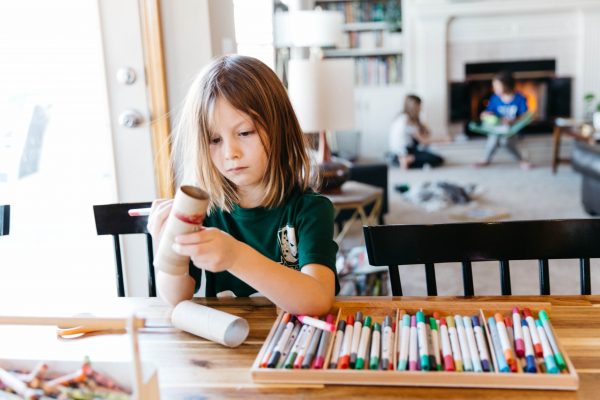
It was truly a bit of an emotional survival season for me, especially towards February and into spring. This inspired me to a lot of thinking and writing, which you know about if you’re a newsletter subscriber!
An unexpected factor in our school year was a leap in independence. My two older girls (9 and 11) have entered a place of being able to do all of their school work themselves. In fact, it was to the point that they lost patience with our morning basket (which they’ve always loved) and just wanted to read their own books. I can’t say they don’t come by that rightly, but boy, I was not ready for it! (And yes, I still made them do morning basket!)
We leaned heavily on interest-led learning with almost no parent-organized projects. We did our skill-building subjects and read alouds about an average of three days a week. My girls spent a lot of time creating, drawing and sewing on their own. We relied on YouTube tutorials quite a bit.
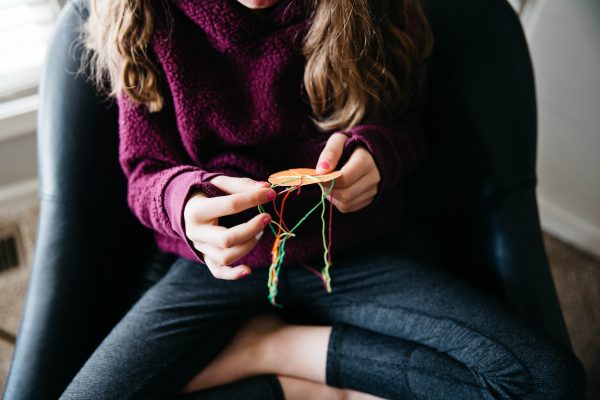
My youngest daughter was six this year, so we introduced her to phonics and math for the first time.
I thought that maybe we’d be able to move back into doing most of our work in the morning since my son is moving out of toddler years. Unfortunately, that still isn’t an optimal format for us and we continued to do most of our school work in the afternoons during his nap. (More on how we structure a school day here.)
Here’s a break-down by subject!
Literature/History/Geography/Science
As you probably know from previous posts, we use a family-centered, literature-based curriculum from The Peaceful Press. It’s an engaging format that covers literature, science, history and geography across multiple ages. This year we studied North American history using The Playful Pioneers. The spine of the curriculum is the Little House series which we’d already read a few times over, but my younger daughter enjoyed really hearing them for the first time.
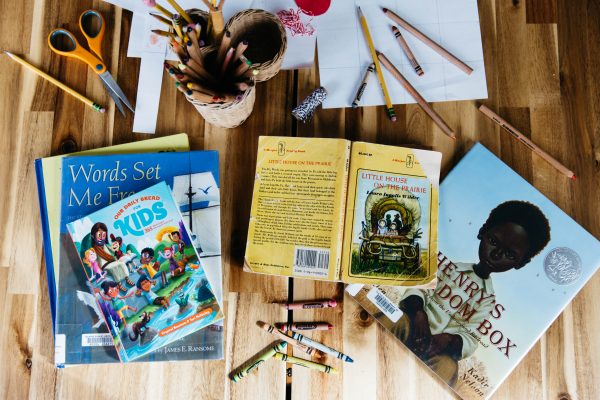
We used the picture books this year but I didn’t do very may of the hands-on projects or recipes, though we’ve always enjoyed those things in years past! We really just squeaked by with Bible reading, picture books and read alouds! (I guess we took the “playful” part of the Playful Pioneers seriously!)
Math
For the past several years we have used Math U See, with both of my older girls in the same level. (One is “ahead” and one is “behind.”) We also started my youngest daughter (6) at the primer level and finished about two thirds of the book.
We take a mastery approach to math which means we move through it as slowly as we need to until they understand the concept. I have one daughter who requires a lot of time and repetition. I have another daughter who loves to zoom ahead. In fact, she wanted to do multiple math lessons in a day. That was when I realized I needed to hand it off (I really don’t want to do more than one math lesson in a day.)
So in February we switched her to a digital math program called Teaching Textbooks that does all of the teaching and lesson practice on a computer. She loved it, especially being able to do as much math as she wanted to. It’s a fun program geared towards kids with animations and little prizes. Of course, as soon as my older daughter saw it, she wanted in! Suddenly I wasn’t teaching math to two of my kids anymore!
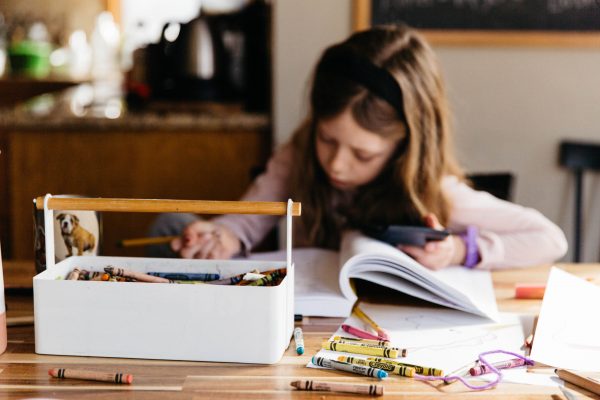
This is not the first time I have switched math curriculums in the middle of the year. When I do this, I simply start them back at the beginning of whatever level we are in. It’s just less complicated and really doesn’t hurt them to have the review. It also doesn’t hurt to have the positive experience of mastering something they feel comfortable in.
Not only was this fun for my kids, but it took a major burden off my shoulders in a year where I really needed it!
Phonics/Reading
As for reading, my older two girls read and listen to audiobooks voraciously. Nowadays my job has become researching great titles that match their interest and keeping them stocked up with their own reading material.
My youngest daughter was ready to start learning to read, so we introduced her to the Explode the Code workbooks. She started reading Bob Books and mastered all of the preliminary books (letter sounds) About halfway through the first book (blending) she was burnt out and frustrated and asked to quit.
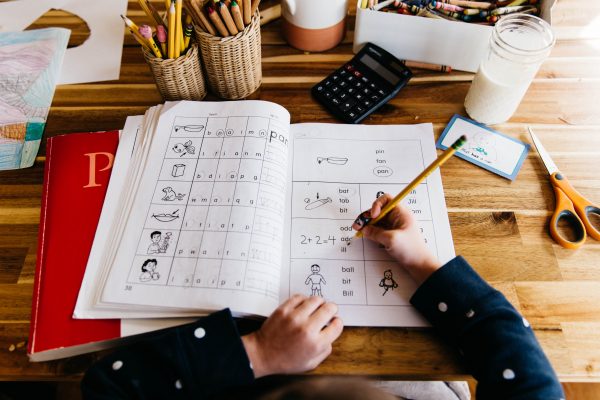
This was in March, so I put the books away in a drawer and told her that we would try again next year. Since we’ve done that, she gets the books out and works independently on her own when she feels inspired. (Oh, it turns out she can actually read and write, but she wanted to be the one to initiate it.)
Writing/Spelling
Our only writing practice alternated between keeping journal entries and doing pages in a spelling book. (I would either give them prompts or ask them to narrate something we had learned.) To be honest it was very few and far between. They’re good writers and I correct punctuation and grammar on the spot as needed.
My oldest daughter also did quite a volume of creative writing. Both of them love to write letters to friends, which also counts as writing and grammar practice for me! June dictated her journal entries to me and did some introductory handwriting practice.
Homeschool Co-op
Another major change this year was that my oldest daughter did one day a week at a Christian homeschool co-op. At the time I enrolled her, I had no idea what a gem it would be and how much it would mean to her. (It was born of a desperate Google search for a girl missing friends!)
There’s a developmental age at which girls have a desire to move towards establishing an identity among their peers. As we arrive at this age, I’ve realized how important it is to take an active role at getting my kids plugged into positive and healthy peer interactions that last for longer periods of time. Just like my job has transitioned from reading everything aloud towards helping my girls find their own reading material, I’m also helping them to establish community that will have a positive impact on their lives.
Oh, we won’t quit doing either things (reading aloud or centering life on family), but I’m definitely finding ways to honor this new season of growing up.
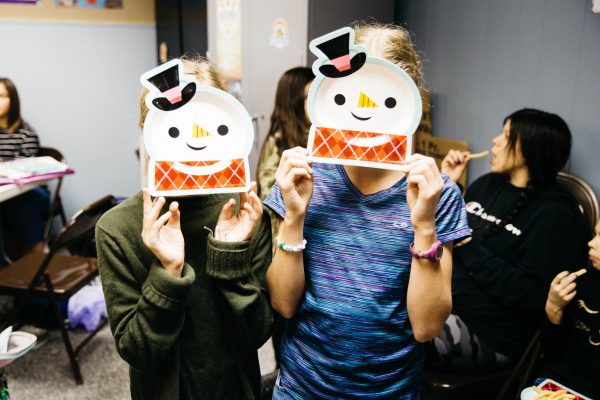
By the way, the co-op I picked is not a parent-led co-op, but more like a private school in that you pay a small tuition fee each month. They only attend one day a week and there is no grade leveled material. Everything else functions like a classic school classroom with fun activities like P.E., theater and holiday fairs.
I learned how motivating it was for my daughter to do school work in a social environment. (She has a high sanguine temperament.) She made some sweet friendships, which she was really longing for. Next year all three of the girls will be going.
To be honest, this positive experience had an influence on our decision to stay living in Kansas City for the next few years–everyone wanted a chance to go to HCA! It was hard to find these kinds of established structures where we lived in California, especially faith-based ones.
Notes
Unschooling is our main philosophy (more about that here), but we utilize some Charlotte Mason principles to enrich our home and equip our kids to self-educate.
Each year I choose a literature-based curriculum or book list along with one math and one language arts program. From about September to about March, we do short lessons, projects and read alouds with these curriculums. The remainder of our time is spent on interest-led learning. I plan our year without a calendar or planner using a simple homeschool planning schema.
CORE RESOURCES USED THIS YEAR: